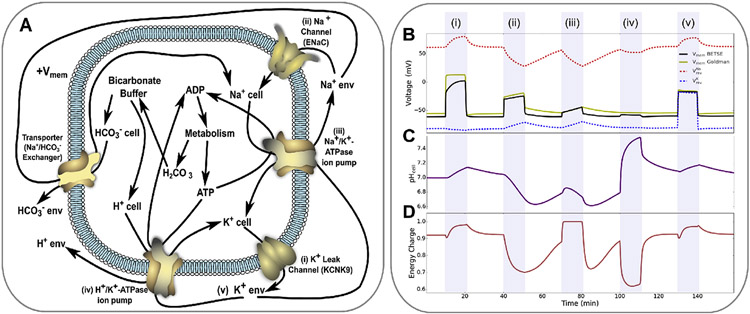Fig. 3.
Bioelectricity encompasses several interrelated phenomena, including ; ion channel, pump and transporter dynamics; and instructive correlations between downstream signaling regimes including pH and metabolism. This bioelectrical example simulation of Na+,K+-ATPase pumps, H+,K+-ATPase pumps, K+ and Na+ leak channels, and a Na/HCO3− transporter, with bicarbonate buffer and metabolic production equations, is detailed in (A), and was simulated in BETSE. The simulation explored a series of 10 min interventions, each separated by 20 min, including: blocking K+ leak channels (i), opening Na+ leak channels (ii), blocking Na+,K+-ATPase pumps (iii), activating H+,K+-ATPase pumps (iv), and increasing extracellular K+ levels (v). , intracellular pH, and energy charge of the cell are shown in B, C and D, respectively. Blocking K+ leak channels depolarizes , and leads to an increase in both cytosolic pH and the energy charge of the cell (i). Opening Na+ leak channels also depolarizes , but leads to significant drops in cell pH and energy charge (ii). Blocking the Na+,K+-ATPase pump leads to slight depolarization and significant increases in cell pH and energy charge (iii). Activating an H+,K+-ATPase has minimal effect on , but significantly increases cell pH and decreases energy charge (iv). Increasing extracellular K+ depolarizes (v). Note that the molecular perspective of bioelectricity provides an accurate estimation of ( BETSE and Goldman series of B), while managing interventions that alter ion reversal potentials (B).

